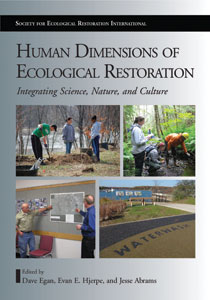"This was my introduction to ecological restoration and I was genuinely impressed by the number of disciplines, ways of thinking, and approaches that were integrated into one book."
Ecological Restoration
"...the editors have compiled a useful selection of papers that help readers appreciate what human dimensions are and how they might figure into an ecological restoration project. They also help readers appreciate that human dimensions might range from the relatively simple to the very complex."
Restoration Ecology
"This book is most appropriate for practitioners collecting the tools they will need to build resilience in social-ecological systems....Educators too can use the case studies to inform and inspire students outside the traditional classroom."
Ecology
"[T]he first book of its kind to provide a comprehensive overview of the ways in which people intersect with and ultimately determine the success of those efforts."
Electronic Green Journal
"Egan, Hjerpe, and Abrams offer the most comprehensive treatment of the human dimensions of ecological restoration to date. From the sychological, social, and cultural aspects of restoration to political, economic, and educational issues, its chapters describe successful restoration in a world dominated by humans. This book will contribute to theory and application and belongs on the bookshelf of scholars, students, and practitioners alike."
Paul H. Gobster, Research Social Scientist, US Forest Service
"By placing humans in nature at the center of restoration and focusing on the themes of participation, power, and perspective, Human Dimensions of Ecological Restoration provides a valuable contribution to furthering the restoration of our planet. This book offers useful insights for a broad range of professionals, including land managers, restoration practitioners, and nongovernmental organizations. Anyone teaching ecological restoration will find this work a valuable classroom reference."
Peter J. Daugherty, Acting Private Forest Divisions Chief, Oregon Department of Forestry
"Egan and his coeditors provide the first comprehensive attempt to apply social science concepts and analyses to the challenges of ecological restoration and to illustrate them with practical, illuminating case studies. Their multiperspectival approach—value-laden, context-driven, complex, and demanding attention to the interaction of classic social forces of culture, economics, and power—is exactly what is needed."
Jill M. Belsky, Professor of Rural and Environmental Social Science, University of Montana

